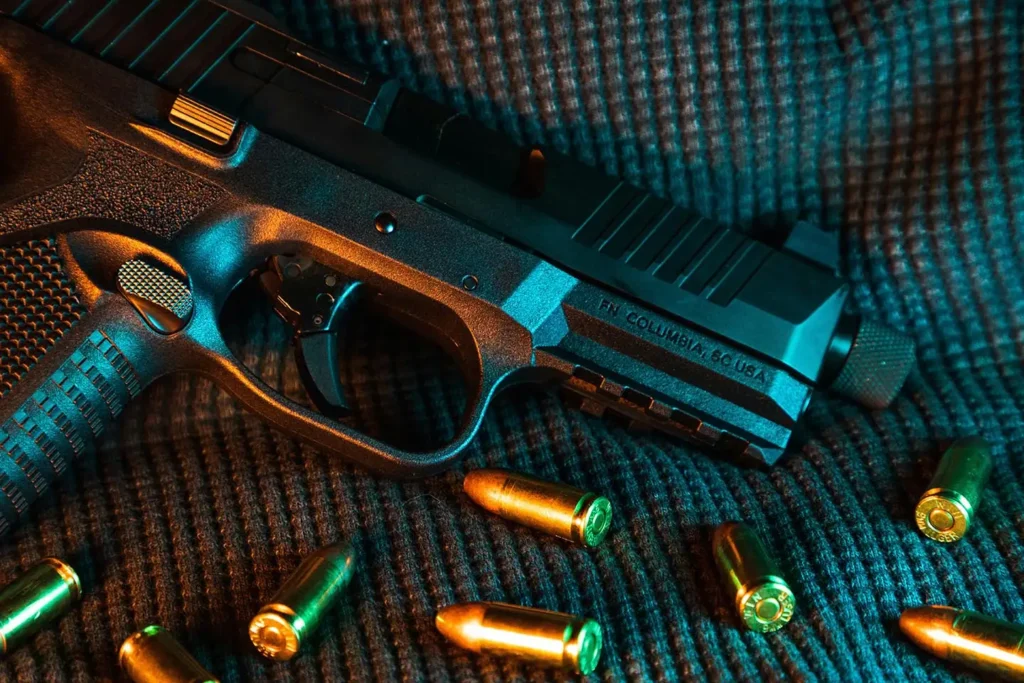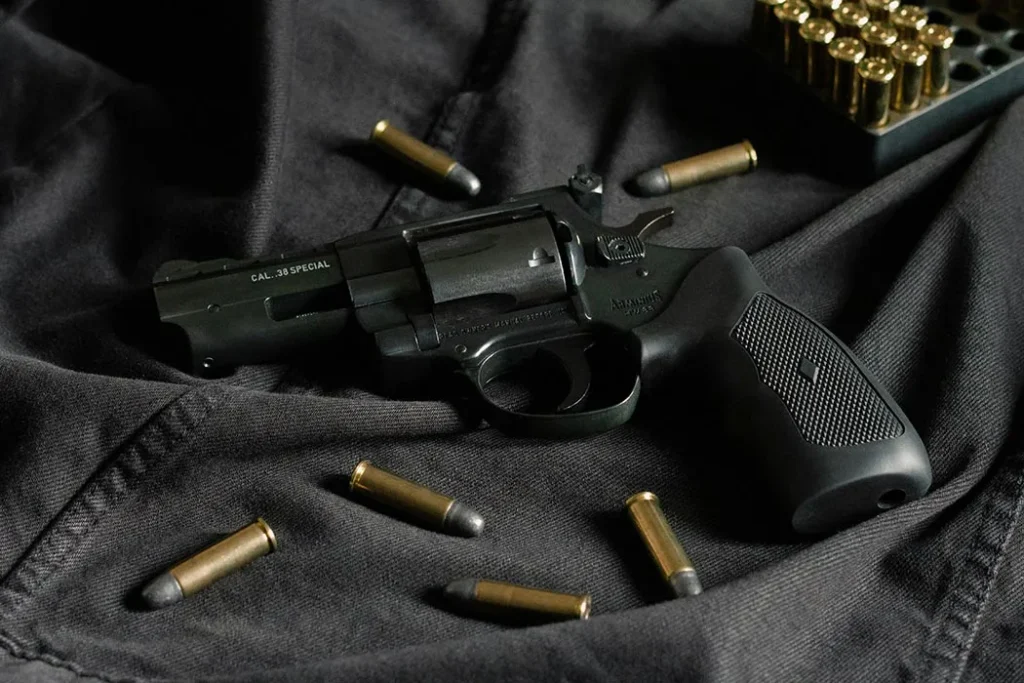Firearms and Weapons Offences



Understanding Firearms and Weapons Offences
In New South Wales firearms and weapons offences are governed by the Firearms Act 1996, the Crimes Act 1900 and the Weapons Prohibition Act 1988. This legislation regulates the possession, use, purchase, manufacture and supply of firearms and components.
A ‘firearm’ is defined broadly as a gun or other weapon, that is (or at any time was) capable of propelling a projectile by means of an explosive. This includes blank firearms and air guns. The legislation also treats ‘replica’ firearms that are not specifically produced and identified as a children’s toy, in the same manner as the firearm, gun, pistol, rifle or weapon that they represent.

Facing Firearm or Weapon Offences


What are Firearms and Weapons Offences?
Unauthorised possession or use
Section 7A of the Firearms Act 1996 provides that a person must not possess or use a firearm without a licence or permit.
Under section 7(1) of the Firearms Act 1996 a person must not possess a prohibited firearm or pistol unless authorised by a permit or licence. Prohibited firearms include machine guns, sub-machine guns and self-loading or pump-action shotguns. The maximum penalty for this offence is 14 years imprisonment.
In order to prove this offence the prosecution must establish beyond a reasonable doubt that:
- The accused was in possession of or used a prohibited
a. firearm; or
b. pistol - AND either of the following
a. the accused did not have a licence to do so; or
b. the accused had a firearm but was not using or possessing a firearm in a way that contravened a condition of their licence; or
c. the accused had a firearm licence but was using the firearm otherwise than for the purpose established by them as being the genuine reason for possessing or using the firearm.
- arguing the defence of necessity and establishing that the accused was compelled by a threat of danger to commit the offence
- arguing the defence of duress and establishing the accused was under pressure or undue persuasion by another person to commit the offence
- arguing that the accused had a licence that allowed them to possess the pistol
- arguing that the accused had a licence that allowed them to use the pistol in the manner that they were
- arguing that the firearm does not fall within the definition of a prohibited firearm
- arguing that the accused could not have reasonably been expected to know the firearm or pistol was in their house or car
- arguing that the firearm or pistol was brought into the accused’s home or car by someone who was lawfully authorised to possess it.
The maximum penalty for this offence is 5 years imprisonment.
This offence is a ‘Table 2’ offence which means that the matter will likely be dealt with by the Local Court, however, the Director of Public Prosecutions can elect to have this matter dealt with by the District Court. If they do so this will give rise to harsher penalties.
Section 36 of the Firearms Act 1996 provides that a person must not supply, acquire, possess or use a firearm that is not registered.
The maximum penalty for this offence is 5 years imprisonment. If the firearm concerned is a pistol or prohibited firearm, the maximum penalty is 14 years imprisonment.
Under section 39(1) of the Firearms Act 1996 a person commits an offence if they fail to take all reasonable precautions to ensure the safekeeping of a firearm and to ensure it is not lost or stolen and that it does not come into the possession of someone who is not authorised to use it.
The maximum penalty for this offence is a fine of $2,200 and/or imprisonment of 12 months. If the firearm is a prohibited firearm or pistol the maximum penalty is a fine of $5,500 and/or imprisonment of 2 years.
Section 40 and 41 of the Firearms Act 1996 makes it an offence for the holder of a firearms licence to fail to store the firearms according to the requirements for the firearm whenever it is not in use.
The requirements for storage and the penalties for failing to comply with them vary depending on the category of firearms licence concerned.
The maximum penalty for an offence under section 40 is 12 months imprisonment and/or a fine of $2,200. The maximum penalty for an offence under section 41 is 2 years imprisonment and/or a fine of $5,500.
A Firearms Prohibition Order prohibits a person from possessing a firearm. Such an order may be made if a person is, in the opinion of the Commissioner, not fit to possess a firearm.
A person who is subject to a Firearms Prohibition Order must not acquire, possess or use a firearm. Doing so in contravention of an order is an offence punishable by a maximum penalty of 5 years imprisonment or 14 years imprisonment if the firearm is a prohibited firearm or pistol.
It is also an offence to supply a person who is subject to a Firearm Prohibition Order with a firearm or for such a person to live at premises where firearms are kept. Such a person must also not without reasonable excuse, attend a shooting range or a firearms club.

Common Firearms and Weapon Penalties
Penalties
The above offences can be dealt with summarily in the Local Court if both the defence and prosecution agree to this. In the Local Court the maximum penalty that can be imposed for a single offence is 2 years imprisonment.
The seriousness of a firearms offence is assessed based on the purpose for which the firearm was being used. If a firearm was used in connection with criminal activity this makes the offence more serious, however, the courts have also held that they must enforce firearms legislation to ensure the regulation of firearms in the community not only when they are used in connection with crime.
Types of sentences that may be imposed for weapons offences include:
- Sentence of full-time imprisonment
- Intensive Corrections Order
- Community Corrections Order
- Section 10A (conviction with no further penalty)
- Fine
- Conditional Release Order with a conviction
- Conditional Release Order without a conviction
- Section 10 dismissal
An Intensive Corrections Order (ICO) is a custodial sentence of up to two years that the court decides can be served in the community. It is the most serious sentence that an offender can serve in the community.
Courts can add conditions to an ICO such as home detention, electronic monitoring, curfews, community service work (up to 750 hours), alcohol/drug bans, place restrictions, or non-association requirements. Offenders may also be required to participate in programs that target the causes of their behaviour.
If an offender breaches an ICO the offender does not go before the Local Court. Less serious breaches can be dealt with by a Community Corrections Officer, and more serious breaches can be referred to the State Parole Authority who may revoke the ICO, requiring the offender to serve the remainder of their sentence in custody.
A domestic violence offender can only be sentenced to an ICO if the court is satisfied that the complainant or likely co-residents can be adequately protected. For example, a domestic violence offender is not eligible for an ICO with a home detention condition if they are intending to reside with the victim.
Community Correction Orders can be used by courts to punish offenders for crimes that do not warrant imprisonment or an ICO, but are too serious to be dealt with by a fine or lower-level penalty.
The benefit of a CCO is that it is a flexible sentence that the court can tailor to reflect the nature of the offence and the offender’s subjective circumstances.
The court can select from a range of conditions, such as supervision by Community Corrections Officers, community service work (up to 500 hours) and curfews, to hold a particular offender to account and reduce their risk of reoffending. A court can also mandate psychological treatment under this order.
CCOs can be imposed for a period of up to three years.
A CCO always has a requirement for an offender to be of good behaviour, meaning they are not to commit any further offences. If any conditions under this order are breached, the order can be called up by the court and the offender sentenced for the offence that placed them on the order along with the offence that brought them back before the court.
There are two types of Conditional Release Orders, one where a conviction is imposed and one where a conviction is not imposed. Courts have the discretion to impose a conviction on a CRO if they consider it appropriate.
Courts typically sentence an offender to a Conditional Release Order without a conviction if they are before the court for the very first time, if the offence is not objectively serious in the circumstances and where the court is of the view that the offender is unlikely to present a risk to the community.
A conviction is usually imposed on a CRO when the court is of the view that the objective seriousness of the offence warrants a conviction. For domestic violence offences the principle of general deterrence plays greater weight, meaning the courts are required to reflect the community standards when sentencing.
The benefit of CROs is that the court can impose conditions such as drug and alcohol abstention, programs, non-association requirements or place restrictions where appropriate. CROs can also have a supervision condition. CROs can be imposed for a period of up to two years.
A CRO always has a requirement for an offender to be of good behaviour, meaning they are not to commit any further offences. If any conditions of this bond are breached, the bond can be called up by the court and the offender sentenced for the offence that placed them on the bond along with the offence that brought them back before the court.
